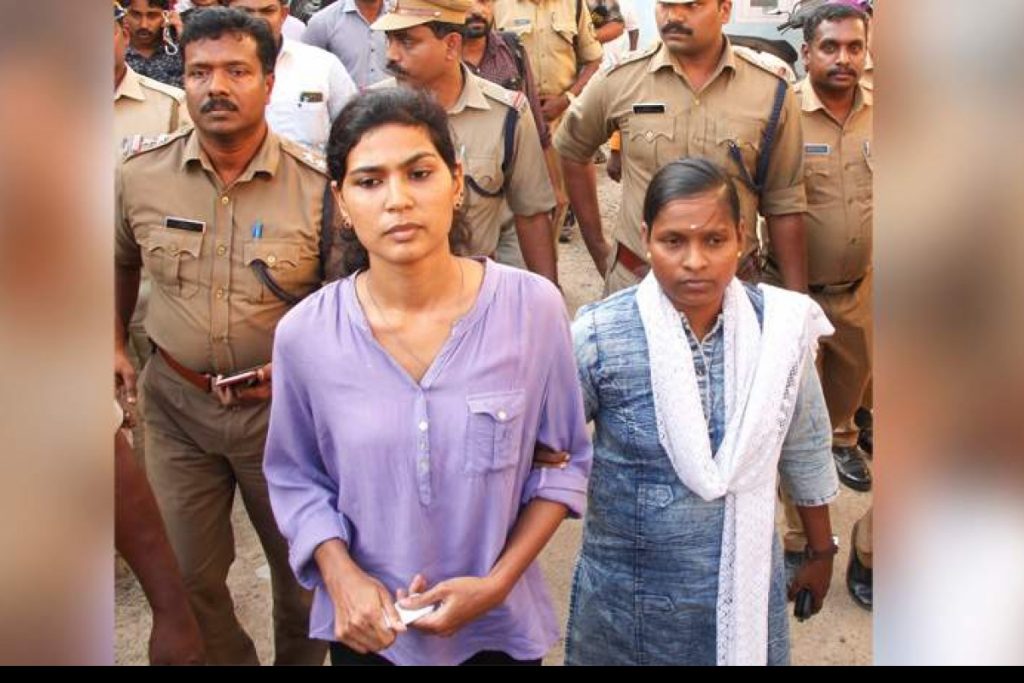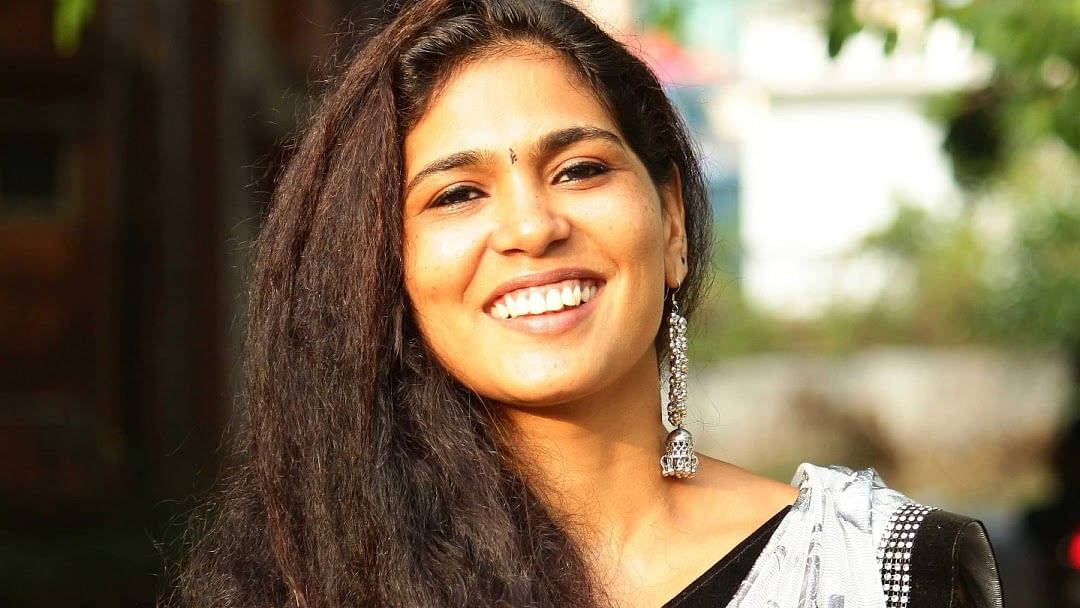Editor’s Note: This month, that is July 2020, FII’s #MoodOfTheMonth is Feminism And Body Image, where we invite various articles about the diverse range of experiences which we often confront, with respect to our bodies in private or public spaces, or both. If you’d like to share your article, email us at pragya@feminisminindia.com.
We control, denigrate and commoditise female body—control by telling how to dress and when to undress, denigrate by violating at will, and commoditising by using women’s body as a product. As Kanchan Mathur states in an article, “…female body is constantly under pressure to conform and mould into prescribed social and cultural roles.” The body is thus the starting point for any movement for change.
How do we tell our sons and daughters that body is an important political weapon?
Rehana Fathima may have tried to answer this when she allowed her son to paint on her body. The two-minute video shows her son painting an angel-like figure in the upper part of the body starting from between the breasts and flowers around both nipples. A little girl is also seen in the video painting on a paper. She posted it in her YouTube channel.

It quickly turned controversial. YouTube categorised it as an age-restricted video. Other YouTube videos criticising the video came to the fore. The male Indian boiling point was tested in the comments section (‘whore’, ‘incest’, ‘when will you show back side?’ and such intellectually inspiring questions). Most importantly, legal proceedings were initiated against her. Her home was raided and personal property (among other things, brush used for painting, according to reports) was seized. Rehana Fathima had to move the High Court for anticipatory bail. The offences charged relate to transmission of ‘sexual’ material and cruelty to children.
How do we tell our sons and daughters that body is an important political weapon?Rehana Fathima may have tried to answer this when she allowed her son to paint on her body. The two-minute video shows her son painting an angel-like figure in the upper part of the body starting from between the breasts and flowers around both nipples.
I do not intend to comment on the legal or moral aspects (in short, prosecution most probably will fail. Morality is too subjective). But, the incident shows us how state action can capture public imagination and block conversations between the female body and the public. If our initial response to such incidents is the invocation of criminal law, which is the strongest arm of state power, then we will never be able to give breathing space for relevant dialogues.
According to Andrew Ashworth, a leading criminal law scholar, “criminal liability is the strongest formal condemnation that society can inflict.” It has the effect of labelling things or persons as ‘criminal’. The result is a deep imprint on the society regarding those actions. Consider, for example, homosexuality. There is evidence that it was ‘tolerated’ behaviour in India. British law criminalised it and changed our perception towards it, sowing seeds of into lerance. Same is the case with adultery(thankfully ‘decriminalised’) and bigamy.

Within crimes, consider the attention given to financial crimes and body offences (rape, murder etc.). Rape leads to social stigma for both the offender and the victim or survivor. Financial offences are quickly erased from public memory even if it has a huge impact. Thus, by calling something as ‘crime’ or as in this case ‘abuse’, the state labels something over which there has been no policy or discussion. If there was a policy or law that provides that children cannot paint on their parents’ body, we can accept it as legitimate (though unreasonable) exercise of power. But, presuming something as abusive blocks any potential dialogue on the same. Here, state oversteps, takes a paternalistic stance and says, “That is wrong” without proper explanations.
Also read: A Note Of Empathy For The Vilified Female School Teachers
So, has there been any policy on exposure of the women’s body to children?
As another YouTube channel (“The Mallu Analyst”) comments, eyebrows are never raised when male body is displayed in the form of six-pack abs, biceps etc. Dr. Jayashri, a social activist based in Kerala observes (in a video uploaded on Rehana Fathima’s channel) gives a sharp commentary of male gaze and body politics. She says that the woman’s body has always been a site for venting out sexual frustration. It has always been considered weak, disabled and without a mind. It has remained invisible to policy makers.
Kerala could have set an example because of the otherwise favourable conditions—literacy, left-leaning government, strong human indicators, political awareness etc. But it sought out to take this action from the other ‘Kerala’—high rise in domestic violence, child pornography and online sexual abuse. Remember, it is the same place where women had once fought for the right to cover their breasts.
YouTube categorised it as an age-restricted video. Other YouTube videos criticising the video came to the fore. The male Indian boiling point was tested in the comments section (‘whore’, ‘incest’, ‘when will you show back side?’ and such intellectually inspiring questions). Most importantly, legal proceedings were initiated against her. Her home was raided and personal property (among other things, brush used for painting, according to reports) was seized. Rehana Fathima had to move the High Court for anticipatory bail.
India has been a symbol of hypocrisy when it comes to women’s bodies. Husbands and courts insist on women wearing sindhoor. At the same time, marital rape is not an offence. We have an invisible rule-book by which women are expected to present their body, even if they are being groped or subjected to violence.
Rehana Fathima has given a detailed description below her video, where she argues that naked body is the response to a controlling, sexually frustrated society. There are other videos that analyse the pros and cons of the situation and argue in her favour. But, all this happens in the like-dislike universe of social media, where trends and topics change daily. The state is the only agency that can initiate important conversations relating to the body and herald an era of acceptance.
What can the state do?
In the same way as we are concerned about mobile apps becoming child porn hubs, we should be concerned about opening up the space for dialogue between the individual and the body. Concern must be shown initiating public dialogue and not by leaving it to sensationalist mainstream or social media. We can start by telling our kids that it’s not a big deal. But, a police jeep coming and taking their painting brushes is not the picture we want to draw for them.
Also read: Feminist Decoding Of Kamasutra: A History Of Socio-Sexual Subjugation
Imagine a country where the trending challenge is body art by child on her mother.
*Updated on 27th July, 2020:
On July 24th July, 2020, Justice P.V. Kunhikrishnan, a judge at the Kerala High Court dismissed Rehana’s anticipatory bail application. After watching the video, he primarily inferred that Rehana used her children for pornographic purposes. To quote, “(T)he children are represented in an indecent and obscene manner because they are painting on a naked body of their mother.” Further, the judge said, her expression when her breasts are being painted is important. But, the judge does not stop there. He pointed out that if it was done within the four walls of the house (and not uploaded), then there is no offence. But, here comes the catch. Quoting Manusmriti and Quran, he observes that a mother has greater responsibility towards her children.
How do we read this order?
Remember, this was a bail proceeding where the only question is whether the accused should be given protection from potential arrest. It is not a trial, where the ‘merits’ of the case are usually gone into. But, as the judge himself notes, he is ‘compelled’ to do so because Rehana argued that there was no case here. I have already argued that this issue requires a deeper and broader introspection (mother-child relations, body images, sex education, parenting etc.). But, it has been reduced to a child porn case. It has been pushed to the tricky area of obscenity law, which is at an intersection of criminal law and morality (read it as – ‘depends on the judges’ individual perception’). The only takeaway is this—a male judge feels that the only question is whether the video where a child is painting on his mother’s semi-naked body is obscene. All other questions need no answers.
Sridip is an assistant professor at NMIMS School of Law, Hyderabad. He is interested in human rights and criminal law. You can find him on Twitter and Instagram.
Featured Image Source: Pennews




